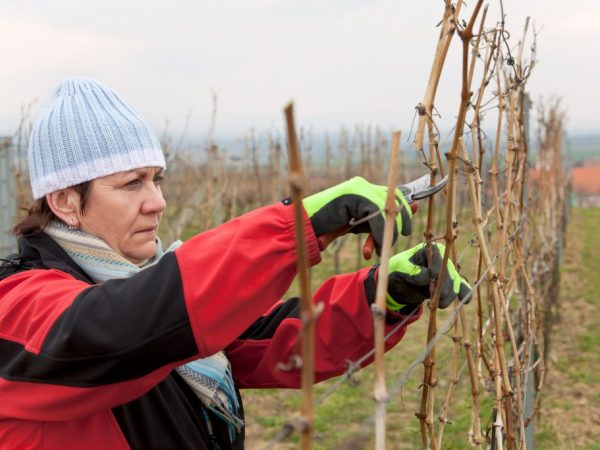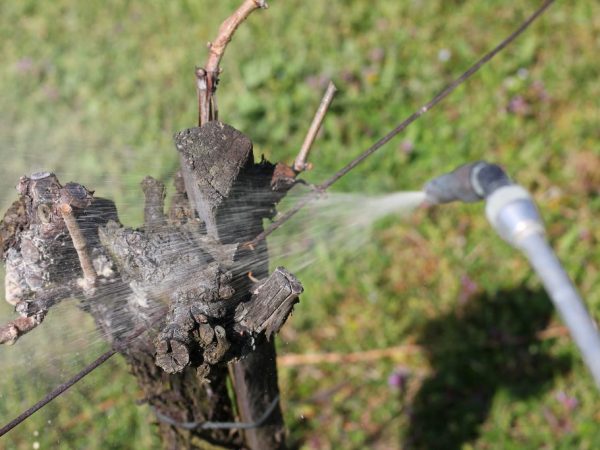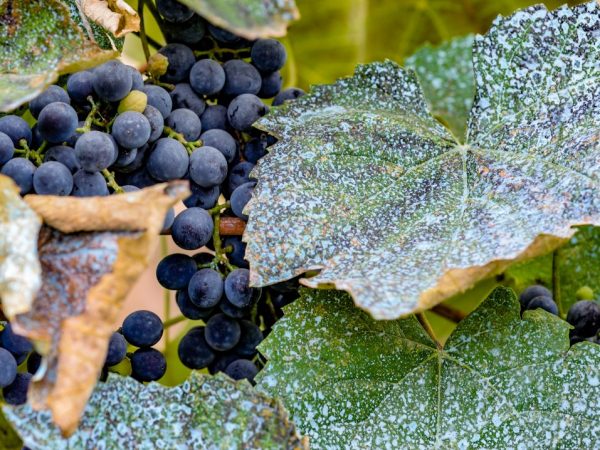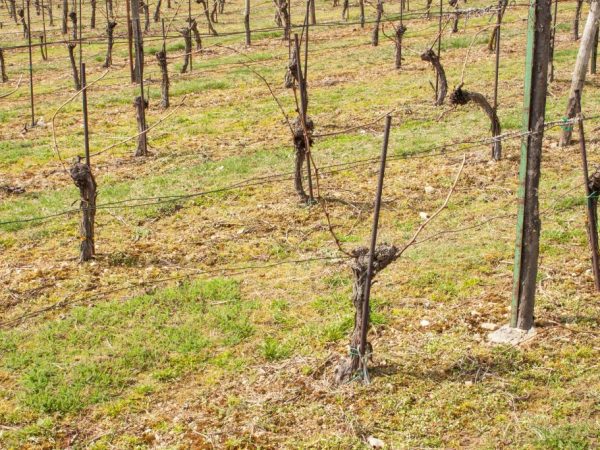Autumn processing of grapes
Grapes are a popular culture among gardeners. Its fruits are used in cooking, medicine and winemaking. The plant is demanding to care for and does not tolerate cold weather. In order for the bush to survive the winter normally, grape processing is required in the fall. It includes pruning and chemical treatments.

Autumn processing of grapes
Pruning
Caring for grapes to prepare for winter begins with pruning. The preparatory stage takes place immediately after harvesting the fruits. The branches are cleaned of fruiting segments, weak shoots and tops that interfere with the development of fruits. Autumn processing of grapes begins in the period of leaf fall.
The first step is to remove young shoots on perennial segments. Choose those that formed at a height of 60 cm and below. The rest of the shoots are removed 2-4 cm from the top. All side stepsons are also cut off.
After a while, the main shoots are chosen, which are left for the winter. A replacement knot is formed in the lower part. To do this, cut off the eyes on the main lower branches, leaving 3-4 pieces.
opposite shoots, located above, are not pruned so much. They are used as a fruit arrow. They leave 6-10 eyes, depending on the diameter.
Only the strongest and most perennial trunks are left in the vineyard. Several buds are left on the sleeves for future fruiting. All branches are removed from the trellises and placed on the ground parallel to the growth of the vine.
Spraying
Autumn spraying of grapes is carried out from pests and viral diseases. For the prevention of diseases, several groups of drugs are used.
Insecticides for insect control:
- Tiovit Jet;
- Inta-Vir;
- "Fosbecid";
- "Cydial";
- Aktelik;
- "Etaphos";
- "Zolon".
Acaricides for mite and spider control:
- DNOC;
- Talstar;
- "Karate";
- Apollo;
- Bi-58 New;
- "Neoron".

Processing is carried out in the fall
Fungicides to fight viruses and infectious diseases:
- "Ordan";
- "Topaz";
- "Bordeaux liquid";
- "Idol";
- Kolosal;
- "Serocin";
- Phthalan;
- "Strobe";
- Horus;
- "Atian";
- "Eupren".
Treatment of the vine in the fall is carried out when the chemicals will not harm the fruit. Spraying is done for each bush. Prevention helps prevent infestation of the plant and helps it endure the cold.
Copper sulfate
The advantage of processing grapevines in autumn with copper sulfate is its non-toxicity. The substance does not harm humans if it remains on branches or gets into the ground. Copper sulfate affects the resistance of bushes to frost. Iron is prohibited to use in the fall: it has the opposite effect.
The liquid should be sprayed on the vine and soil near the bush after the leaves fall. For better penetration, foliage is removed from the soil. Vineyard spraying takes place in 2 stages with an interval of 20 days.
It is important to spray before the frost begins.Vitriol creates an airtight shell on the surface, which retains heat in the branches and does not allow pests to penetrate.
For spraying, the substance is diluted in warm water in a ratio of 1 to 40. The liquid is stirred until smooth. Slaked lime is added to enhance the preventive effect.
The vineyard is processed within 3 hours after preparation. After that, the solution will begin to thicken, which will not allow using it with a sprayer. For 1 plant, 1.5-2 liters of solution are used.
Bordeaux liquid

Bordeaux liquid will protect against fungal diseases
Autumn processing of grapes with Bordeaux liquid is carried out to prevent fungal diseases such as melanosis and black rot. The tool is bought in a store or made independently. The purchased liquid is diluted to a 4% concentration so as not to harm the plant. It is forbidden to spray the vineyard with the agent more than 5 times a year.
To prepare Bordeaux liquid you will need:
- 500 g quicklime;
- 250 g copper sulfate
- 8 liters of boiled water.
Vitriol is dissolved in boiling water and diluted with cold water. Lime is diluted in a plastic container. Substances are filtered and mixed until homogeneous.
When processing, the dosage is observed, since the substance has a large amount of copper in its composition. It can harm the human body. For 1 bush, 1 liter of Bordeaux liquid is used.
Urea
You can treat grapes in the fall against fungal diseases with urea. It also helps with pests such as aphids, weevils, and copperheads. Prevents the appearance of scab.
To treat the grapes with urea, an aqueous solution is prepared. The ingredients are taken in a ratio of 1 to 6. The crown of the plant is sprayed 40-50 days before the appearance of frost. It is better to process immediately after dropping the foliage.
Top dressing
To enhance the effect of urea treatment and prevent the appearance of a viral disease in winter, dry top dressing in the form of urea is additionally introduced into the soil. The solution changes its structure under the influence of bacteria and enhances the healing effect.
Urea is applied to a depth of 30-40 cm. This allows the root system to absorb the required amount of phosphorus and potassium. It is forbidden to apply top dressing superficially: this stimulates the roots to grow upward.
To treat mites, grapes are treated with colloidal sulfur before winter. It destroys pest spores and prevents anthracosis and powdery mildew. The vine is sprayed before the shelter for the winter.

Sulfur destroys harmful bacteria
Sulfur creates a protective coating on the branches and destroys harmful bacteria. For preparation, 1 sachet of the substance is diluted in 6 liters of water. For 5 take 1 liter of funds. Handle with protective gloves.
Spraying with soda and potassium permanganate
To prevent gray rot and powdery mildew, grapes are treated with a mixture of soda and potassium permanganate. The remedy also helps against aphids and caterpillars, and its composition improves the development of the plant. The substance affects the taste of the fruit, making it sweeter.
To prepare a product from potassium permanganate, mix 2 g of permanganate and 400 ml of water. Boric acid is also added to the product, which serves as an additional top dressing.
To prepare an antifungal agent from soda, you must:
- 5 liters of water;
- 20 g of baking soda;
- 30 ml of vegetable oil;
- 100 ml of soap.
The product is used for spraying. Processing is carried out on a cool, cloudy day.
Barrel processing
From the appearance of fungal diseases in winter, painting the lower branches with slaked lime helps. For this, a solution is prepared from a substance diluted in water.
For 5 liters of water, take 500 g of quicklime and quench it in 1 liter of water. The product is stirred until a homogeneous consistency and the thick trunks are painted with a silicone brush.
Shelter for the winter
The application of the grape shelter complements the chemical treatment, keeps the plant warm and prevents the appearance of fungi and harmful insects.Ground cover is one method. The treated vine is laid on the ground and covered to a height of 17-25 cm. The soil next to the plant is not taken, so as not to damage the roots.
In cold regions, where there is a risk of freezing the ground, the grapes are covered with acrylic. This treatment allows you to cover not only the trunks, but also the roots. Additionally, snow retention is carried out to prevent moisture stagnation.
An air cushion is created on top of the cover. To do this, use branches of spruce branches, tomatoes or raspberries. They cover the grapes, and on top are covered with several layers of film. Such a shelter completely protects against the appearance of dampness in early spring, which prevents fungal diseases. To prevent the plant from becoming moldy, 2-3 holes are left in the film on different sides. Also, slate or plastic is used as a covering material.
Conclusion
Autumn processing of grapes affects the development of the plant. Fungal infections are difficult to clear. Their treatment requires the removal of the affected segments, which affects the growth of the bush.
In winter, the soil around the grapes is sprinkled with salt. It draws out excess moisture, which is the cause of disease. It is also important to make mineral and organic fertilizers.


